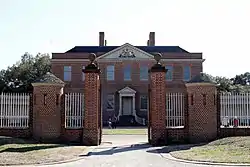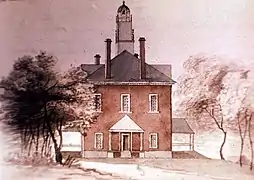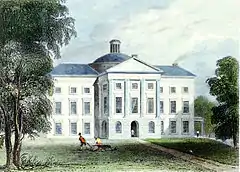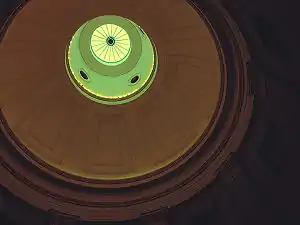North Carolina State Capitol
The North Carolina State Capitol is the former seat of the legislature of the U.S. state of North Carolina which housed all of the state's government until 1888. The Supreme Court and State Library moved into a separate building in 1888, and the General Assembly moved into the State Legislative Building in 1963. Today, the governor and their immediate staff occupy offices on the first floor of the Capitol.
North Carolina State Capitol | |
 | |
  | |
| Location | 1 E Edenton St, Raleigh, North Carolina |
|---|---|
| Coordinates | 35°46′49.3″N 78°38′20.8″W |
| Built | 1833 |
| Architect | Multiple |
| Architectural style | Greek Revival |
| Part of | Capitol Area Historic District (ID78001978) |
| NRHP reference No. | 70000476 |
| Significant dates | |
| Added to NRHP | February 26, 1970[1] |
| Designated NHL | November 6, 1973[2] |
| Designated CP | April 15, 1978 |
History
The building was built following the destruction by fire of the first North Carolina State House in 1831,[3] and today houses the offices of the Governor of North Carolina. It is located in the state capitol of Raleigh on Union Square at One East Edenton Street. The cornerstone of the Greek Revival building was laid with Masonic honors by the Grand Master of North Carolina Masons Simmons Jones Baker on July 4, 1833.[4] Construction was completed in 1840.[5] It was designed primarily by the architectural firm of Ithiel Town and Alexander Jackson Davis. Often credited solely to that team, the design of the capitol was actually the result of a sequence of work by William Nichols, Sr. and his son William Nichols, Jr., Town and Davis, and then David Paton.[6] The Capitol housed the entire state government until 1888, and the North Carolina General Assembly met in the capitol building until 1961. The legislature relocated to its current location in the North Carolina State Legislative Building in 1963. The North Carolina Supreme Court has also convened in the building in the past, most recently meeting in the capitol's senate chamber in 2005 while the Supreme Court Building was undergoing renovations. The Governor and the governor's immediate staff has continued to occupy offices in the building.[7] The Capitol remains largely unaltered from its 1840 state. Only three rooms have been significantly altered through remodeling: the two committee rooms in the east and west wings of the second floor, which were divided horizontally to provide space for restrooms, and the office in the east wing of the first floor, part of which had to be cut away to permit space for an elevator to be installed in 1951.[8] The Capitol was declared a National Historic Landmark in 1973 and the building is located in the Capitol Area Historic District.[2][9]
The first assembly to meet in this building was the 63rd North Carolina General Assembly of 1840-1841 on November 16, 1840. The last assembly to meet in this building was the 124th North Carolina General Assembly of 1961, which met from February 8 to June 22, 1961.[10]
North Carolina legislature buildings
The North Carolina General Assembly may have initially met in Tryon Palace after being vacated by the British in 1776. The assembly met in various locations until a building dedicated for use by the state government was completed in 1794 in Raleigh. This building was destroyed by fire in 1831. The North Carolina State Capitol building was the home to the assembly from 1840 to 1961.[10]
| Name | First Occupied (Assembly) | Last Occupied (Assembly) | Picture |
|---|---|---|---|
| Tryon Palace | 1777 (1st) | 1777 |  Tryon Palace |
| North Carolina State House | 1794 (19th) | 1810 (35th) |  North Carolina State House |
| Renovated North Carolina State House | 1811 (36th) | 1831 (55th) |  Renovated North Carolina State House |
| North Carolina State Capitol | 1840 (63rd) | 1961 (124th) |  North Carolina State Capitol |
| North Carolina State Legislative Building | 1963 (125th) | still in use | .jpg.webp) North Carolina State Legislative Building |
Images of the North Carolina State Capitol building
In the rotunda is a statue of George Washington. The rotunda statue is a replica of the original statue by Antonio Canova, which was destroyed by a fire in 1831. A bust of the 29th Governor of North Carolina (1841–1845), John Motley Morehead, sits inside the capitol. A statue of George Washington is on the south side of the capitol. On the east side of the capitol sits a statue of the three Presidents of the United States from North Carolina: James Knox Polk of Mecklenburg County, Andrew Jackson of Union County sitting on horse, and Andrew Johnson of Wake County. The grounds of the capitol also include statues honoring women of the Confederacy, veterans of the Civil War and Viet Nam War.[11]
 George Washington Statue at North Carolina State Capitol
George Washington Statue at North Carolina State Capitol Statues of U.S. Presidents from North Carolina
Statues of U.S. Presidents from North Carolina Classical Greek Facade of North Carolina State Capitol
Classical Greek Facade of North Carolina State Capitol Interior view of dome.
Interior view of dome. Bust of Governor of North Carolina John Motley Morehead
Bust of Governor of North Carolina John Motley Morehead North Carolina State Capitol In 1861
North Carolina State Capitol In 1861 South side of the State Capitol, 2016
South side of the State Capitol, 2016
See also
References
- "National Register Information System". National Register of Historic Places. National Park Service. January 23, 2007.
- "Capitol (North Carolina)". National Historic Landmark summary listing. National Park Service. Archived from the original on 2007-08-22. Retrieved 2008-02-24.
- Miskimon, Scott A. (2010). "The Fires of 1831: Fayetteville and Raleigh in Flames". NCPedia.org.
- Smith, Claiborne T., Jr. (1979). Powell, William S. (ed.). Dictionary of North Carolina Biography. 1 (A-C). Chapel Hill, North Carolina: University of North Carolina Press. pp. 92–93. ISBN 0-8078-1329-X.
- "North Carolina Historic Sites: State Capitol". Raleigh, North Carolina: North Carolina Historic Sites. 2010-06-14. Archived from the original on 2013-06-07. Retrieved 2011-02-04.
- "Nichols, William (1780-1853)". North Carolina Architects and Builders: A Biographical Directory. The NCSU Libraries Digital Scholarship and Publishing Center. Retrieved 2009-11-29.
- "Conservation and Preservation of the State Capitol Historic Site". North Carolina State Capitol Foundation. Retrieved 2015-05-14.
- North Carolina State Capitol Docent Manual. NC Division of State Historic Sites, NC Department of Cultural Resources, 4/2012
- Zehmer, Jack; Ingram, Sherry (April 22, 1970). "National Register of Historic Places Inventory-Nomination: Capitol" (pdf). Digital Archive on NPGallery. National Park Service. and Accompanying five photos, exterior and interior, from c. 1940 and 1969 (32 KB)
- Cheney, John L. Jr., ed. (1975). North Carolina Government, 1585-1974, A Narrative and Statistical History.
- Williams,Wiley J. (2006). "State Capitol". NCPEDIA. Retrieved November 21, 2019.
External links
| Wikimedia Commons has media related to North Carolina State Capitol. |



